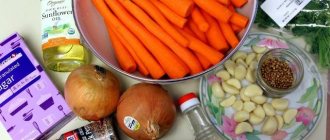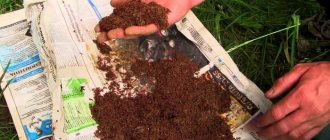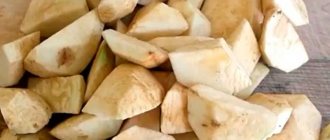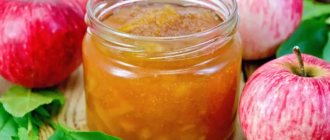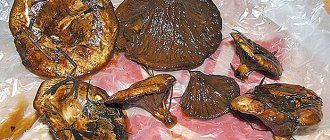Features of the structure
In order for a root crop to be well preserved until spring, it must have a certain structure and composition. Carrots intended for storage must have a high percentage of dry matter, sugars and carotene.
The drier the carrots, the more resistant they are to pathogenic bacteria and microorganisms that lead to product spoilage.
Particular attention should be paid to the shape of the vegetable . Experienced gardeners say that medium-sized and conical-shaped carrots are best stored. It is unacceptable to store carrots with damaged skins, dents, or cuts. It will very quickly become unusable and can “infect” a healthy crop.
How to properly store carrots: 8 ways
Of all the root crops grown by gardeners in their summer cottages, carrots are the most difficult to preserve during the winter. The inquisitive minds of gardeners have come up with many ways to store carrots: in cellars, on balconies, in apartments and even directly in beds.
- Method No. 1. How to store carrots in sand
- Method No. 2. Storing carrots in sawdust
- Method number 3. How to store carrots in plastic bags
- Method number 4. Storing carrots in clay
- Option 1.
- Option 2.
- Method No. 5. Storing carrots in moss
- Method number 6. Storing carrots in pans
- Method No. 7. How to store carrots in onion skins
- Method No. 8. Storing carrots in the garden
- A few more original ways to store carrots
How to properly store carrots? Based on the existing conditions, the complexity of the process and the availability of materials, choose the most suitable storage option for you from the storage options offered below.
Preparing carrots for long-term storage
The first rule for good preservation of the carrot harvest is proper and timely harvesting.
The ripening time for carrots depends on the variety and is usually indicated on the packet of seeds. It is better not to throw away the bag or to calculate the expected harvest day in advance, in the spring. Why? Carrots pulled out ahead of time do not ripen and do not have time to accumulate a sufficient amount of sugars, which negatively affects its taste. Carrots that are over-exposed in the garden, on the contrary, have an excess of sugars and amino acids, and this, in turn, makes them a tasty morsel for pests - carrot fly larvae, mice and rats.
If you still don’t know exactly when to harvest carrots, focus on the color of the tops. As soon as the lower leaves begin to turn yellow, the carrots are ready for harvesting. To ensure that root crops remain juicy for a long time, they should not be watered the day before digging.
Immediately after harvesting, the tops of the carrots are cut off. Otherwise, it will draw some of the moisture from the root crops during drying. It is best to trim carrot tops in two stages: - first, the leaves are cut off just above the head of the root crop, - then the “head” is cut off completely (0.5-1 cm thick) together at the growth point, and the cut should be even and smooth. Such drastic pruning prevents carrots from germinating in winter, wasting precious nutrients, prevents fruits from withering, and ensures their best storage.
Varieties
Not all carrot varieties are suitable for long-term storage. The main indicator characterizing the ability of a root crop to retain useful qualities for a long time and not deteriorate is keeping quality. In turn, it depends on the speed of carrot ripening and the expected harvest date.
The main principle is this: the later the carrots were planted and the later they ripened, the longer they will last. Therefore, it is worth choosing late-ripening or mid-ripening varieties.
- Late-ripening carrots with good keeping quality - Valeria, Forto, Vita Longa, Moscow winter, Carlena, Flakkoro.
- Mid-season carrots - Incomparable, Nantes-4 and Callisto - are considered the best for storing for the winter.
- Hybrid varieties with late ripening - Tinga F1, Totem F1. In addition to keeping quality, they have excellent yield.
Important! Carrots intended for winter storage must be ripe and harvested on time. In a mature root crop, the lower leaves of the tops begin to dry out.
Which varieties are suitable for storage are described in detail here.
Selection and preparation of suitable fruits
The correct choice of root vegetables is a very important moment. Not all varieties of carrots can be stored for a long period of time.
Preference should be given to late-ripening varieties (Chantane, Queen of Autumn, Cascade, Carlena). Mid-season varieties are stored worse. Only certain varieties can last for a relatively long time: Red Giant, Moscow Winter, Flakke, Viking, Altair.
Early ripe vegetables cannot be stored for long periods of time because they spoil very quickly.
Before laying, the fruits must be prepared:
- Vegetables are carefully inspected and sorted. Only ripe, hard root vegetables without visible damage are placed in the first pile. Soft, damaged and greenish ones should be used immediately or frozen.
- If there are lumps of soil left on the fruits, carefully shake them off. It is not recommended to wash them. After peeling, the vegetables are dried in the shade for 2-3 days.
- It is advisable to harvest the harvest of each variety separately, because carrots tend to sprout. It is also recommended to store large and small fruits in different containers.
There is no confirmed information about the influence of the shape and size of the fruit on its shelf life. But experienced vegetable growers advise putting aside medium-sized cone-shaped vegetables for the winter.
Storage methods in the cellar
The cellar is an ideal winter storage option for carrots . However, it is relevant only for private houses. But owners of dachas, sheds or garages with an equipped cellar can also use the method. Sometimes owners manage to “equip” apartments on the first floors of houses with a basement for storing vegetables and homemade preparations.
Special conditions must be observed in the cellar: the optimum temperature is about 2 degrees and the relative humidity is 90-95%. The room must be ventilated, but without intensive air supply, otherwise the tops will begin to sprout.
How to store in the cellar:
- In wooden or thick cardboard boxes with a lid - they are placed on a small stand that protects from moisture, 15 cm away from the walls.
- In onion peels - carrots are placed in large bags, sprinkled with peels, then each bag should be tied.
- In pine sawdust , boxes and other containers are used, carrots and pine needles are laid in layers.
- In a mixture of wet sand and chalk , the substance is poured into a box, and carrots are placed there with the thick tip up.
- In plastic bags - several holes are made in the bags at the bottom to allow condensation to drain, and the crop is placed on shelves and stands without tying the packaging.
Methods for storing carrots
Storage in a basement or cellar
. At the moment, the best way is in a cellar or basement, where conditions are ideal or close to it. There are several options for storing carrots in the basement. I’ll try to remember everything that can be safely used to preserve your harvest. Go?
In boxes
. Here, we lay the carrots in layers and sprinkle them with damp (not wet) river sand. Note that the sand must be processed (sifted and calcined). You can also use sawdust from coniferous trees instead of sand. Where, sawdust releases substances (phenolic), which help preserve vegetables for a long time. We remember that the sawdust must be fresh. We do the same as with sand.
On a note!
The peels from onions and garlic help preserve carrot roots for a long time. This happens because the husk contains phytoncides. And they do not allow various bacteria and other microorganisms to multiply. Thus, they prevent the development of many diseases or at least simply minimize their development. Arrange it interspersed with carrots wherever you like. For example, in bags, boxes, racks.
How to store carrots in clay
Solutions based on clay and chalk, paraffin
. Here, we prepare solutions based on clay or chalk. They are prepared the same way. Either clay or chalk is diluted with water to the state of liquid sour cream. Then, the vegetable must be dipped in the solution, dried and stored in boxes or simply on racks (shelves). In this case, the shells prevent the carrots from deteriorating and rotting ahead of time. Don’t forget to thoroughly dry the processed fruits after this (this is very important).
I hope everything is clear with paraffin. Melt, dip in paraffin, dry.
In plastic bags
. Almost any size bags are suitable for this method. The main thing here is ventilation holes or just an open bag. Then condensation does not form, and this is how the vegetables are preserved.
Don't forget to check the packages for rot. And, be sure to monitor the temperature and humidity in the storage. Note that in small bags it is easier to sort through root vegetables. You can preserve vegetables in this way for no more than 4 months.
On a note!
We keep carrots away from other vegetables, especially apples and potatoes.
Where is better?
Where is the best place to keep carrots and beets in a city home? It is much more difficult for apartment owners to preserve carrots until spring and choose a place to plant the vegetable. There are several ways to store root vegetables in an apartment:
- A glazed loggia or balcony - they can become an alternative to a cellar. In this case, you can use the methods that are used for basement storage.
- Cool pantry.
- Fenced and protected stairwells.
- Fridge.
- Freezer.
- In jars in dried form.
Shelf life for different methods
What is the best and longest way to preserve carrots until spring, and how to do this correctly at home so that they do not dry out over the winter? Carrots are difficult to store, but if you choose the right method, you can save the vegetable for a long time.
Shelf life of carrots:
- From 2 to 3 months - in plastic bags.
- From 4 to 5 months – in paraffin.
- From 5 to 7 months - in boxes.
- From 6 to 8 months - in the sand.
- 1 year – in clay.
- 1 year - in needles.
How to do it?
The easiest way to preserve carrots so that they do not wilt or spoil is to place them on a glazed loggia or balcony. But this requires strict temperature control. If the room freezes, the crop will also freeze, becoming unsuitable for food. If it is warm on the balcony, the vegetables will quickly sprout and spoil.
Balcony storage options:
- Carrots are placed in wooden or cardboard boxes, and the fruits should not touch each other.
You should also prepare wet sand and sprinkle root vegetables with it. Sometimes ash is mixed into the sand - it has bactericidal properties. - Unwashed root vegetables are placed in boxes in layers - each layer is covered with newspapers. The box is covered on top with plastic film to maintain an optimal level of humidity, and on top with thick fabric.
- The method of harvesting carrots in onion peels, by analogy with storing them in a cellar, can also be used in an apartment. But in this case, the vegetables may fade over time.
- Unwashed, unpeeled carrots are loosely placed in a wooden box. The box is carefully wrapped in a cotton blanket so that air and sunlight do not get inside. The top of the container can be covered with felt.
Prepare a creamy clay solution. Dip each fruit into clay, dry it naturally, put it in a plastic bag, and tie it. Clay creates an impenetrable shell that prevents drying and penetration of microorganisms. To prepare a clay solution, the clay is poured with water twice - the first time for swelling, the second time - a day later, until a liquid consistency is formed.- Paraffin will help preserve carrots for a long time. It works the same way as clay. You need to melt a sufficient amount of paraffin (according to the volume of the harvest), lower each root crop, take it out and dry it. This way you can make preparations not only for storage on the loggia, but also in the refrigerator.
- Place the root crop in cardboard boxes along with the horseradish roots. For every 20 fruits, take 1 medium horseradish rhizome and distribute it evenly in the container. The box must be tightly closed during storage.
- Several carrots (2-3 pieces) and one small horseradish root are wrapped in cling film and placed on a balcony or loggia in any container.
- Sawdust is poured into a layer of 3-5 cm at the bottom of a deep box, then carrots are laid out, another layer of sawdust (1-2 cm) is placed on top, and so on until the container is filled.
- Storage in vacuum bags for freezing is not able to preserve the freshness and integrity of root vegetables for a long time. But this method can be used if you need to preserve the harvest, for example, until the New Year holidays. Carrots are placed in airtight bags and placed in the refrigerator or on the balcony.
Some owners experiment and use several storage methods at once. For example, they are stored in boxes along with husks, or root vegetables treated with clay are placed in sand.
If there are only a few carrots, you can use the pantry for storage . Wipe the carrots first, removing excess dirt and soil, wrap each fruit in newspaper and place randomly in boxes.
An alternative storage method is the drying method. You can dry the vegetable in a natural way - outdoors in dry sunny weather. You can also use kitchen appliances – microwave, oven, electric dryer. The output is crushed pieces that can be stored for a long time in ordinary jars with lids.
How to store carrots in the refrigerator, method No. 1:
How to store carrots in the refrigerator, method No. 2:
Processing methods
How to process carrots for storage? Do I need to wash carrots before storing them? There are several ways to store carrots. Before this, the vegetable is treated with a solution of potassium permanganate .
White rot , which affects fruits, spreads quickly when they are stored in the same container, this differs from black rot, which is not transmitted from root crop to root crop.
Treatment of pure carrots with potassium permanganate is carried out in a large container (basin or bath). A dark purple solution is prepared and poured onto the vegetables placed there. The exposure lasts up to 2 hours, then the carrots are removed and dried on thick fabric or tarpaulin.
This method of treatment is only effective against damage to root crops by white rot and pests. The possibility of fruit damage due to black rot remains. The procedure for processing carrots before storing them for winter storage is as follows:
- Pulled or dug up root crops are thoroughly cleaned of dirt .
- Each carrot is inspected for damage.
- To wash or not to wash carrots before storing? It is washed if dirt is smeared on them and there is no other way to remove it.
- The tops are trimmed in the manner described above.
- The carrots are dried in the air, preferably not in the sun , but under some kind of shelter.
- Clean containers are prepared for it - wooden boxes, plastic bags or sacks, but it can be stored without it - in bulk piles.
- Treatment with potassium permanganate (its solution) is done
- The first layer of carrots is placed in a box and sprinkled with sand .
- Then, layer by layer, each box is filled to the top, but not closed and placed in the basement for storage.
Tips for preparing root vegetables for storage in this video:
How to ensure vegetable freshness longer?
In order for carrots to last as long as possible, it is necessary to properly prepare the crop:
- Carrots are strictly forbidden to be washed (read about whether you should wash carrots for storage here). The only exception is vegetables for drying and freezing.
- The entire batch of carrots is carefully inspected. Rotten, wilted, damaged fruits are subject to discarding.
- Dry the sorted specimens slightly naturally. It is better in the wind, and not in direct sunlight. In this case, you need to turn the fruits over from time to time.
- Observe the temperature and humidity conditions in the storage room.
Practice shows that if the technology for preparing and storing root vegetables is followed, carrots can be stored:
- 1 year – using paraffin, clay;
- six months - in bags with onion peels, boxes with sand, ash or sawdust;
- 2-4 months – in plastic bags;
- 1-2 months – in the refrigerator.
Warnings
- If the carrots were poorly sorted, then the damaged fruits will begin the process of rotting, as a result of which the entire crop may be spoiled.
- If the temperature of the room in which the carrots are stored exceeds 5 degrees, they will begin to germinate.
- If the storage temperature drops below 0, the root crop may freeze and become flabby.
- To keep carrots in the refrigerator for as long as possible, you need to thoroughly rinse them with water, dry them, and wrap each fruit in cling film.
Thus, if someone who grows carrots does not have a cellar for storing vegetables, there is no need to despair: there are many other ways. They allow you to store vegetables not only in your summer cottage, but also in your apartment. However, in order for it to retain its qualities for as long as possible, it is necessary to adhere to the rules.
If you find an error, please select a piece of text and press Ctrl+Enter.
Why do vegetables spoil?
Many owners make typical mistakes when storing root vegetables. This leads to premature spoilage of the product, loss of taste and beneficial properties.
- Why do carrots rot? There is high humidity in the room. In this case, condensation settles on the fruits and provokes the proliferation of microbes.
Solution: ventilate the room, arrange a stand for a box or bag, and periodically sort through the fruits.
- Why do carrots sprout? The rules for cutting tops or the temperature conditions are not followed (the room is too warm).
Solution: cut the tops right down to the petiole, move them to a cooler room, periodically inspect the workpiece and sort through it.
- Why do carrots wither? The rules for assembling and drying the root crop were violated; the carrots were overexposed to the sun or harvested too early.
Solution: learn from your own mistakes and prevent a similar situation next year.
Necessary conditions for indoor vegetable storage
To maintain freshness, a temperature range from 0 to +2℃ is required. At higher temperatures, the process of wilting and germination will begin. If the thermometer reads below zero, the root vegetables will freeze.
It is clear that it is impossible to maintain the optimal temperature for storing vegetables in a living room.
If the layout does not provide for a balcony or cellar suitable for storing vegetables, the crop can be stored for a long time without additional processing only in the refrigerator.
The fruits are placed in plastic bags and placed on the bottom shelf (or in a special box for vegetables). As necessary, remove the carrots from the bag, after which it is tightly closed again.
However, by treating the fruits with manganese or paraffin, you can achieve long-term storage even in apartment conditions. The rules are simple:
- do not store vegetables near heating appliances;
- frequently ventilate the room;
- do not allow air humidity to increase.
It is better to store fruits in a box with sawdust or sand.
Additional Tips and Warnings
- It is not recommended to store carrots in the same room as apples. The fruit releases ethylene, which leads to carrot spoilage.
- Vegetables that are grown for a long time in the same area and heavily flavored with nitrogen fertilizers will not be stored for a long time.
- The period of time between harvesting and storage should be minimal - a few days.
- Thick and juicy fruits are better stored, while small and thin ones are better eaten earlier.
Storing carrots is not an easy task, but it can be done. By adhering to the rules of harvesting and storing, you can provide your family with vitamins throughout the winter.
If you find an error, please select a piece of text and press Ctrl+Enter.
Prohibitions
In the process of harvesting carrots, some prohibitions must be taken into account:
- Damaged root crops are not stored for the winter. They should be processed or consumed first.
- Ventilation should not be too great - otherwise the vegetables will begin to sprout.
- The harvest should not be stored in a dry room - the vegetables will spoil due to moisture evaporation.
- Apples and carrots cannot be stored in the same room, as these fruits emit ethylene, which leads to spoilage of vegetables.
- In one box, carrots should be stored in only one chosen way. There is no need to combine everything at once.
How to store carrots in an apartment
A refrigerator and an insulated balcony are suitable for storing carrots at home.
When the temperature changes in winter, it is important to ensure that it does not fall below 0°C on the balcony. The boxes are covered with dark material from the sun's rays
It is convenient to store carrots on the balcony in boxes with sawdust or sand. When it is frosty, they are wrapped in a warm blanket. In extreme cold, they are moved to a warmer place or insulated even more.
In a private house, in a country house
The best option for storing vegetables is the underground of a house or cottage.
When building or purchasing housing on your own plot of land, pay attention to the quality of the underground space - it makes a convenient vegetable storage. Before storing root crops, prepare the storage: remove the remains of the previous harvest, ventilate
If necessary, disinfect the walls, wash the shelves and floor. Cleaning is done a month before planting vegetables, then aired for a long time.
Before storing root crops, the storage area is prepared: the remains of the previous harvest are removed and ventilated. If necessary, disinfect the walls, wash the shelves and floor. Cleaning is done a month before planting vegetables, then aired for a long time.
Store carrots in any way. Boxes and other containers are conveniently placed on lower shelves or on the floor.
In the basement, cellar
A basement is a room in any building that is half underground. It is called the first underground floor.
A cellar is a pit with reinforced walls and a covered top. In private houses, a cellar is called a basement in cases where the foundation of the house is made with a full floor. In village houses, the cellar has ordinary earth instead of a floor, and the walls are the foundation.
The difference in construction does not prevent these premises from having the same characteristics:
- maintaining optimal temperature - not lower than 0°C, humidity - 90-95%;
- air circulation.
In the refrigerator, freezer
Every refrigerator has containers for vegetables. They are located under the lower shelves. Carrots will be stored there for up to four months.
Two ways to keep root vegetables in the refrigerator:
- Wash, cut and dried carrots are stored in plastic bags. If water droplets appear on the bags, it is recommended to dry the vegetables and replace the bag with a dry one.
- Root vegetables are wrapped in a wet cotton towel and placed in the vegetable compartment.
A popular and convenient storage method is in the freezer. Housewives cut carrots for different dishes: into strips, into bars, and grate them on a coarse grater. This saves time during cooking in the future.
Before placing the chopped root vegetables in the refrigerator, they are blanched - scalded with boiling water. As a result, the action of enzymes slows down. The pieces do not lose their taste, color, or structure. Once frozen, blanched carrots retain their nutritional value until the next harvest.
The cooled crushed fruits are laid out on flat surfaces and placed in the freezer for 2 hours. Then they are placed in bags or containers and put in the freezer.
How to store carrots in an apartment
How to stock up on vegetables for the winter if city apartments have neither a cellar, nor a basement, nor a shed?
A glazed balcony or loggia is suitable.
Of course, you will have to make sure that the temperature does not drop below zero and that the carrot stocks are not exposed to sunlight.
Otherwise, your entire crop will sprout and rot.
So let's look at the options.
The simplest and most effective way is to put the root vegetables in a box, crush them with pine sawdust, and wrap them in a thick old blanket.
In the same way, carrots are stored on the balcony in plastic bags. Sugar bags will also work.
When it freezes, vegetables are moved to another place or even further wrapped in dense material, for example, felt.
Arrange root crops in the loggia in boxes with wet sand.
The vegetables will be as crispy and juicy as from the cellar, but they won’t last long on the loggia, only until mid-winter.
Mix sand with ash or ash and bury the carrots there. This will preserve the vegetables a little longer.
Storing carrots in the garage.
If your harvest is small, you can wrap each root crop in newsprint and put everything in a wooden box. For the first time, this supply will be enough for you.
How else do city housewives get out?
Thoroughly washed and trimmed carrots are wrapped in cling film and placed in a container so that the fruits do not touch (this is enough for 45 days).
Carrots are also treated with paraffin. Melt paraffin in a saucepan, place washed and dried carrots in it, they are covered with a paraffin layer and can be stored on the balcony for 4 months.
And, of course, the assistant of every city housewife is the refrigerator.
Place clean, dry and tops-trimmed carrots in small plastic bags and store them in refrigerator drawers.
It is very convenient to store vegetables in special plastic containers with airtight lids (jugs).
Wash and dry the carrots, place a paper napkin on the bottom of the container, fold in the fruits and close the lid tightly.
Supermarkets have a huge assortment of such containers: round buckets, rectangular containers, transparent and colored jars. There are even containers with tags and windows for writing on sale.
Freeze carrots in the freezer.
Chop or grate clean carrots and put them in regular bags. Better yet, prepare a few small bags.
For soups and borscht, grate the carrots on a fine grater. Place diced and sliced carrots in another bag. Another one is straw.
“A little trick: you can package vegetable sets in bags.”
Place diced carrots, zucchini, cauliflower, and sweet peppers in a small bag. You will always have ready-made assorted vegetables on hand.

